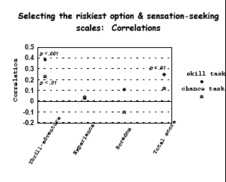A deeper understanding of risk-taking will increase insight about gambling behaviors. Miller & Byrnes have developed a model of risk-taking called the Self-Regulation Model (SRM). The conceptual theory driving the SRM is the following: the key to being successful is knowing how and when to take risks with strategies for accomplishing goals. Specifically, the model poses five self-regulatory tendencies that increase the chances of a risk-taker meeting their specified goal: (1) knowledge of strategies for attaining a goal, (2) ability to coordinate multiple goals, (3) calibrated sense of uncertainty (accurate knowledge of the probability of possible outcomes), (4) self-correcting strategies (to counter biases and limitations such as impulsivity or sensation seeking), and (5) a tendency to learn from experience. In an experiment designed to test the hypothesis, among others, that sensation-seeking was correlated with risk-taking behavior, researchers gave six risk-taking tasks to 115 3rd through 8th grade students. In each of the scenarios, students reported whether they would choose the low risk, moderately risky, or very risky option. Four of the tasks involved skill, and two involved chance. In one of the chance scenarios, participants played a game with dice in which certain numbers produced certain payoffs. Sensation-seeking was measured with selected items from Zuckerman’s Sensation-seeking Scale on three subscales: 1) thrill and adventure seeking, 2) experience seeking, and 3) boredom susceptibility. Selecting the riskiest option for the skill scenarios was positively associated with an interest in thrill and adventure seeking and sensation-seeking (total score). Risky choices on the chance scenarios, however, was positively correlated only with thrill and adventure seeking. A regression analysis determined that thrill and adventure seeking was one of the unique predictors of risky choices for both the chance and the skill tasks. In other words, students scoring high on measure of thrill and adventure seeking were most likely to select the riskiest option, regardless of the nature of the task. Thrill and adventure seeking for both the chance and the skill tasks identified something not explained by the other variables in the regression equations, such as gender, grade, interest, or competitiveness.

Source: Miller, D.C., & Byrnes, J.P. (1997). The role of contextual and personal factors in children’s risk taking. Developmental Psychology, 33(5)814-823.
This public education project is funded, in part, by The Andrews Foundation.
This fax may be copied without permission. Please cite The WAGER as the source.
For more information contact the Massachusetts Council on Compulsive Gambling, 190 High Street, Suite 6, Boston, MA 02110, U.S.




